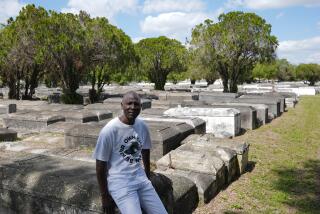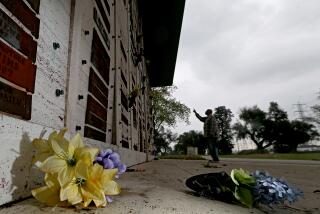Plath’s Grave Now Quiet After Years of Desecration
- Share via
HEPTONSTALL, England — “Even amidst fierce flames the golden lotus can be planted.”
Ted Hughes has said he used to repeat that line from Sanskrit to Sylvia Plath when she was feeling blue, and he chose that line for her gravestone.
It was in the depths of depression, estranged from Hughes and living with two young children in a London apartment, when Plath put her head in a gas oven on Feb. 11, 1963, and ended her life at the age of 30.
Since her suicide 30 years ago, the grave of the Pulitzer Prize-winning poet has been the focus for vendettas by hard-core Plath devotees.
Vandals have three times chiseled off the lead letters spelling “Hughes” on the sand-colored marker.
No one was ever arrested for the vandalism. But it is widely believed that Plath zealots, who objected to her married name on the headstone, were responsible.
“There was recurring interest every two or three years, a little bubble of interest. The trouble tended to be related to outbreaks of publicity,” said the Rev. John Harrison, who had to deal with two desecration incidents during his seven years as vicar of the Church of St. Thomas the Apostle, ending in 1990.
Plath and Hughes met at Cambridge University in 1956. Some critics say Hughes’ influence deepened his wife’s poetic creativity. But more recent interpretations of her life accuse Britain’s poet laureate of smothering her in housework and abandoning her for another woman.
One of the desecration stories, widely reported at the time in 1987, placed the blame on feminists who allegedly made a pilgrimage to Heptonstall, scraped off the letters and later mailed them to the vicarage from Amsterdam.
Harrison said the story is apocryphal.
“Some Dutch tourists found the letters in the churchyard, put them in their pocket and when they returned home thought, ‘Oh, my goodness, I’ve still got these’ and mailed them back. It’s no great mystery. But of course you’ve got the foundation of a very good tale and that got expanded,” he said in an interview.
Plath, who was born in Boston, is buried in the West Yorkshire village next to Mytholmroyd, where Hughes was born and his father owned a shop.
The grave was last desecrated in the spring of 1989 and on a recent rainy afternoon in the austere southern hills of the Pennines the graveyard was quiet with a damp, gray cat weaving between headstones.
Yellow roses, a holly wreath with red ribbons and a clutch of silk lilies of the valley lay atop Plath’s grave in the new, treeless graveyard adjacent to the stone church.
Residents in the old weavers’ village of dark stone, two-story row houses, are pleased that the furor seems to have ended.
“There’s been a lot of weeping, willying and gnashing of teeth over that grave over the years,” said the village postmistress Miriam Dugdale, who closely followed the incidents in her role as church warden.
“They seem to have got over that,” said Donald Willson, 67, a retired grocery owner, sipping a half-pint of bitter in the Cross Inn.
Retired carpenter Fred Else worked on the mill owner’s house Hughes bought just outside the village which is used by a trust supporting writers.
“The villagers never take any interest in it (the grave) at all except for one or two geniuses,” said Else, 84. “We’ve got a couple intellectuals in the village and they were interested.”
More to Read
Sign up for our Book Club newsletter
Get the latest news, events and more from the Los Angeles Times Book Club, and help us get L.A. reading and talking.
You may occasionally receive promotional content from the Los Angeles Times.










